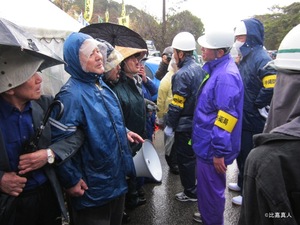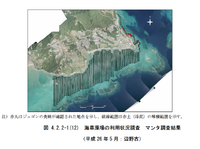Protect Yanbaru Forest and Local Community
2011年02月16日
Call for Your Attention and Action:
Protect Yanbaru Forest and Local Community
from Helipad Construction

Dear Concerned Citizens and Organizations,
On February 3, 2011, amid local people and their supporters’ protests and calls
for dialogue, members of the Okinawa Defense Bureau marched in and began
felling trees in the Takae area of the Yanbaru forest in Okinawa, Japan to resume
the construction of six new helipads for US military.

The resumption of construction has brought a new intensity to the stand off
between the Okinawa Defense Bureau and the local people and their supporters,
who have been carrying out a peaceful sit in protest to protect the living environment
and the Yanbaru forest.


The Citizens’ Network for Biological Diversity in Okinawa (Okinawa BD) is calling for
your attention to this latest development in the Yanbaru forest and is asking for your
action to help halt the Okinawa Defense Bureau’s construction work in the forest.
[Yanbaru Forest]
Located in the northern area of Okinawa Island, the Yanbaru forest (about 26, 000 ha)
is one of the richest areas of biodiversity in Japan. It is home to over 1,000 species
of highplants and 5,000 species of animals, including numerous indigenous and endemic
species such as the endangered Okinawa Woodpecker and Okinawa Rail.
It is also home to people who live in small and isolated communities.
Takae is one of these communities.
The Okinawa prefectural government promotes the Yanbaru forest as a key area
in its efforts to get the Ryukyu Islands designated as a UNESCO World Natural
Heritage Site. The Japanese government announced its intentions to designate
the Yanbaru forest as a national park during the10th Conference of Parties to the
Convention for Biological Diversity (COP10) held recently in Nagoya, Japan.
[Helipad Construction]
Since 1957, the US military has been using a large part of the Yanbaru forest for
training. Today, 30% of the Yanbaru forest is a US military training area. In this
training area, there are already 22frequently used US helipads, causing various
problems to the environment and the nearby local communities. Thus, since
the construction plan was revealed in 1999, local people, NGOs, and experts
have been opposing to the plan and expressing their concerns that the
construction of new helipads in the Takae area will certainly further impact
the Yanbaru forest and the Takae community.
After conducting its Environment Impact Assessment for the helipad construction
plan, the Okinawa Defense Bureau has concluded that the construction and use of
the helipads would have no impact on the environment and the community.
While local people, NGOs, and scientific/experts have criticized theEIA for its lack
of transparency, accuracy, and reliability, the Okinawa Defense Bureau has been
proceeding with the construction plan, based on the EIA’s “no-impact" conclusion.
International voices, meanwhile, have been loud and clear. The International Union
of Conservation for Nature (IUCN) has twice called for conservation of the endangered
Okinawa Woodpaker and Okinawa Rail in the forest. On the occasion of COP10
in Nagoya, the Guardian newspaper urged the Okinawa Defense Bureau to
“consider alternative sites [for helipad construction] that will not impact
Okinawa's unique biodiversity.”
This is why the residents of the Takae community and many others have been
opposing the construction plan and calling for explanation and dialogue with
the Okinawa Defense Bureau.
(For info on actions taken by local communities, NGOs, and scientific
communities, please see the list below).
[Okinawa Defense Bureau Filed Lawsuit]
So far, the Okinawa Defense Bureau has shown no willingness to resolve
the criticism and concerns. Instead, it has reacted to the local opposition
by filing a lawsuit against residents of the Takae community for obstruction
of traffic in November 2008, who were engaged in a peaceful sit in protest
against the helipad construction.
In what many consider a “SLAPP lawsuit,” the court has ordered both
the Okinawa Defense Bureau and the local residents to enter negotiation
outside of court. Negotiation has not, however, has taken place as the
Okinawa Defense Bureau keeps declining to negotiate.
It is in light of these developments that the Okinawa Defense Bureau
marched in and began felling trees in the Takae area of the Yambaru
forest and the stand off between the Okinawa Defense Bureau and
the protesters has intensified.
[Please Voice Your Objection and Concerns!]
We of the Okinawa BD ask the Okinawa Defense Bureau and the Japanese
government to immediately halt the helipad construction in the forest.
We also ask them to enter dialogue with the local people, NGOs,
and experts/scientists in order to seek ways to protect the rich biodiversity
of the Yanbaru forest and the peaceful living environment for the local people.
We invite you and/or your organization to voice your objection to and/or
concern over the resumed construction of helipads in the Yanbaru forest,
and to send them to the Okinawa Defense Bureau, the Japanese government,
the Okinawa prefectural government, and the US government.
Hideki Yoshikawa
Chief Secretary
Citizens’ Network for Biological Diversity in Okinawa
yhideki@cosmos.ne.jp
Contact Addresses:
-Okinawa Defense Bureau
infomod@mod.go.jp
Tel: 81-(0)98-921-8131
Fax: 81-(0)98-921-8168
-Japan Ministry of Defense
infomod@mod.go.jp
Tel: 81-(0)3-5366-3111
-Japan Ministry of the Environment
https://www.env.go.jp/en/moemail/
Tel: 81-(0)3-3581-3351
-Okinawa Prefectural Government/Military Base Affairs Office
okinawa@pref.okinawa.lg.jp
Tel: 098-866-2460
Fax: 098-889-8979
-US Embassy in Japan
http://tokyo.usembassy.gov/e/info/tinfo-email.html
Tel: 81-(0)3-3224-5000
Fax: 81-(0)3-3505-1862
-US General Consulate in Okinawa
NahaACS@state.gov
Tel: 098-876-4211
Fax: 098-876-4243
-US Marines in Okinawa
OkiMarWeb.MCBB.FCT@usmc.mil
-US Department of Defense
http://www.defense.gov/landing/questions.aspx
[On line action to stop helipad construction]
-Stop building US military helipad and save the Okinawa forest!
http://bit.ly/ebAEYt
-----------------------------------------------------------------
Information on Yanbaru Forest, Takae Community,
and Helipad Construction
-----------------------------------------------------------------
[General Information on Yanbaru Forest]
- Okinawa Prefectural Government, “The Nature of Yanbaru”
http://www.wonder-okinawa.jp/004/e/yanbaru/index.html (in English)
- Japan Hotspots, “A Treasure Box of Subtropical Laurel Forests”
http://en.japanhotspot.net/feel/photos/importantecosystem/010001/ (in English)
-Yosiaki Itô, Kuniharu Miyagi, and Hidetoshi Ota, “Imminent extinction crisis among
the endemic species of the forests of Yanbaru, Okinawa, Japan,”
Oryx. Volume 34, Issue 4, pages 305–316 (Oct. 2000). (in English)
http://bit.ly/eOukrA
[Different Actors, Different Actions for Conservation of Yanbaru Forest]
○Okinawa Prefectural Government
Okinawa Prefecture, Nature Conservation Division, “World Natural Heritage Site”
http://www3.pref.okinawa.jp/site/view/contview.jsp?cateid=70&id=19697&page=1
(in Japanese)
Pamphlet with a cover showing a beautiful picture of the Yanbaru forest
http://www3.pref.okinawa.jp/site/contents/attach/10667/H17-1_Pamphlet(P1-P15).pdf
(in Japanese)
○The Ministry of the Environment’s plan to designate the Yanbaru as a national park
Minutes of the 20th Meeting, Oct. 4, 2010 of the Ministry of the Environment Subcommittee
on Natural Park, Nature and Environment Committee, Central Environmental Council,” (Oct. 2010).
http://www.env.go.jp/council/12nature/y121-20a.html (in Japanese)
“Document No. 13: Comprehensive Review on National and Quasi-National Parks.” (Oct. 2010)
http://www.env.go.jp/council/12nature/y121-20/mat13.pdf (in Japanese)
○Citizens’ actions
-Takae People’s Blog, ”What is going on in Takae, Higashi village”
http://takae.ti-da.net/ (in Japanese)
-“Voice of Takae” (Jun. 2008)
http://nohelipadtakae.org/files/VOT-english2010Oct14.pdf (in English)
-Citizens’ Network for Biological Diversity in Okinawa,
“Open Letter to Okinawa Defense Bureau Regarding the US Helipad Construction Plan in Takae” (Jun. 2010)
http://nohelipadtakae.org/files/openlettertoBDfromBD.pdf (in Japanese)
-Takae community adopted resolution to oppose US helipad construction (Oct. 1999).
http://ryukyushimpo.jp/news/storyid-95754-storytopic-86.html (in Japanese)
-Takae community adopted resolution to oppose US helipad construction (Feb. 2006).
http://ryukyushimpo.jp/news/storyid-11420-storytopic-1.html (in Japanese)
-Takae community adopted resolution to stop US helipad construction (Jan. 2007).
http://ryukyushimpo.jp/news/storyid-20539-storytopic-3.html (in Japanese)
-Higashi village assembly passed ordinance to protect Okinawa Woodpecker (Jun. 2010)
http://bit.ly/gdWXcm (in Japanese,see Minutes of the 4th village assembly)
-The Japan Times, “Village moves to save rare woodpecker,” (Jun. 2010)
http://search.japantimes.co.jp/cgi-bin/nn20100611b5.html (in English)
-Ogimi village assembly adopted resolution to oppose US helipad construction in Takae (Jun. 2010).
http://okinawaforum.org/disagreeblog/2010/06/post_168.html (in Japanese)
○NGO actions
-WWF-Japan and Residence’s Group, “No Military Helipads in Yanbaru Forest,” (Jun. 2007).
http://www.wwf.or.jp/activities/lib/pdf/yanbaru0706e.pdf (in English)
- The Nature Conservation Society of Japan (NACS-J),
“Comments on Japanese government’s project of the construction of new US helipad
in the US Marine Corps Northern Training Area, Okinawa,” (Apr. 2006).
http://www.nacsj.or.jp/katsudo/yambaru/2006/04/post-7.html (in Japanese)
- The Nature Conservation Society of Japan (NACS-J), “Comments on Environment
Impact Statement for Japanese government’s project of the construction of new
US helipad in the US Marine Corps Northern Training Area, Okinawa,” (Mar. 2006).
http://www.nacsj.or.jp/katsudo/yambaru/2006/04/post-7.html (in Japanese)
-Wild Bird Society of Japan Yanbaru Branch requested Naha Defense Facilities
Administration Agency(now Okinawa Defense Bureau) to reconsider US Helipad
construction plan (Mar. 1999).
http://library.baidu.jp/view/9fec68eae009581b6bd9ebae.html (in Japanese)
○Voices from academic/scientific societies
-The Biological Society of Okinawa requested Naha Defense Facilities Administration
Agency(now Okinawa Defense Bureau) to reconsider US helipad construction plan
(Jan. 1999), and it adopted resolution to oppose the plan (May 1999).
http://library.baidu.jp/view/9fec68eae009581b6bd9ebae.html (in Japanese)
-The Biological Society of Okinawa requested Naha Defense Facilities Administration
Agency(now Okinawa Defense Bureau) to reconsider its environmental research proposal
for US helipad construction (Aug. 2002).
http://ryukyushimpo.jp/news/storyid-103850-storytopic-86.html (in Japanese)
-The Ecological Society of Japan requested Naha Defense Facilities Administration
Agency (now Okinawa Defense Bureau) to reconsider US helipad construction plan
(Mar. 1999).
http://www.esj.ne.jp/esj/ESJ_NConsv/1999Helipad.html (in Japanese)
-The Ornithological Society of Japan requested Naha Defense Facilities Administration
(now Okinawa Defense Bureau) to reconsider US helipad construction plan (Oct. 1999).
http://wwwsoc.nii.ac.jp/osj/japanese/iinkai/hogo/yambaru.html (in Japanese)
-The Entomological Society of Japan requested Naha Defense Facilities Administration
(now Okinawa Defense Bureau) to reconsider US helipad construction plan (Oct. 1999).
http://wwwsoc.nii.ac.jp/osj/japanese/iinkai/hogo/yambaru.html (in Japanese)
-The Japanese Society of Applied Entomology and Zoology requested Naha Defense
Facilities Administration (now Okinawa Defense Bureau) to reconsider US helipad
construction plan and submitted a petition to Naha DFAA (Jul. 1999).
http://library.baidu.jp/view/9fec68eae009581b6bd9ebae.html (in Japanese).
-The Lepidopterological Society of Japan requested Naha Defense Facilities
Administration (now Okinawa Defense Bureau) to reconsider US helipad construction
plan (Jul. 1999).
http://library.baidu.jp/view/9fec68eae009581b6bd9ebae.html (in Japanese)
-The Herpetological Society of Japan requested Naha Defense Facilities
Administration(now Okinawa Defense Bureau) to reconsider US helipad construction
plan (Nov. 1999).
http://library.baidu.jp/view/9fec68eae009581b6bd9ebae.html (in Japanese)
-Phytogeographical Society adopted resolution to request Naha Defense Facilities
Administration (now Okinawa Defense Bureau) to reconsider US helipad construction
plan (Feb. 2000).
http://library.baidu.jp/view/9fec68eae009581b6bd9ebae.html (in Japanese)
-Japanese Society for Plant Systematics (JSPS) adopted resolution to request Naha
Defense Facilities Administration (now Okinawa Defense Bureau) to reconsider US
helipad construction plan (Mar. 2000).
http://library.baidu.jp/view/9fec68eae009581b6bd9ebae.html (in Japanese)
-Japanese Society for Plant systematics submitted to Naha Defense Facilities
Administration Agency (now Okinawa Defense Bureau) the society’s comments on
the Environment Impact Statement for the US helipad construction plan (Mar. 2006).
http://wwwsoc.nii.ac.jp/jsps/letter/pdffile/NL21.pdf (in Japanese)
○International Organizations
-International Union for Conservation of Nature (IUCN) adopted Recommendation 2.72
“Conservation of Dugong(Dugong dugon), Okinawa Woodpecker (Sapheopipo
noguchii ) and Okinawa Rail (Gallirallus okinawae) in and around the Okinawa Island”
in Oct. 2000.
http://www.nacsj.or.jp/katsudo/iucn/2000/10/1010-1.html (scroll down for English text)
http://data.iucn.org/dbtw-wpd/edocs/WCC-3rd-004.pdfn (in English)
- International Union for Conservation of Nature (IUCN) adopted Recommendation
3.114 “Conservation of Okinawa Dugong, Okinawa Woodpecker, and Okinawa Rail”
in Oct. 2004.
http://www.nacsj.or.jp/katsudo/henoko/pdf/041117iucn_dugong.pdf (scroll down for
English text)
http://data.iucn.org/dbtw-wpd/edocs/WCC-3rd-004.pdf (in English)
-The Guardian, "Biodiversity 100: A campaign to compile a list of 100 tasks for world
governments to undertake to tackle the biodiversity crisis" includes Okinawa:
“Action: Preserve the biodiversity on Okinawa Island”
http://www.guardian.co.uk/environment/2010/oct/04/biodiversity-100-actions-asia (in English)
-Center for Biological Biodiversity, “Saving the Okinawa Woodpecker”
http://www.biologicaldiversity.org/species/birds/Okinawa_woodpecker/ (in English)
-The Alliance for Zero Extinction, AZE identifies Yanbaru as one of the 587 sites of
pinpointing and conserving epicenters of imminent extinctions (Oct. 2010)
http://bit.ly/hdKefN
http://www.zeroextinction.org/sitedata.cfm?siteid=584
-American Bird Conservancy
Bird Call, Vol.5, No.2, p.14, (August, 2001), American Bird Conservancy
http://www.abcbirds.org/newsandreports/birdcalls_pdf/bc01aug.pdf (in English)
○A quote from The IUCN’ Red List of Threatened Species”:
http://www.iucnredlist.org/apps/redlist/details/141804/0
Major Threat(s): Its decline is primarily attributable to deforestation, which continues
at a significant rate as a result of logging, dam construction and associated
road-building, agricultural development and golf course construction. Construction of
six new helipads near the village of Takae in the US Marine Corps Northern Training Area
began in 2007 and represents a further potential threat to remaining areas of forest.
The species’ limited range and tiny population make it vulnerable to extinction from
disease and natural disasters such as typhoons.
Protect Yanbaru Forest and Local Community
from Helipad Construction

Dear Concerned Citizens and Organizations,
On February 3, 2011, amid local people and their supporters’ protests and calls
for dialogue, members of the Okinawa Defense Bureau marched in and began
felling trees in the Takae area of the Yanbaru forest in Okinawa, Japan to resume
the construction of six new helipads for US military.

The resumption of construction has brought a new intensity to the stand off
between the Okinawa Defense Bureau and the local people and their supporters,
who have been carrying out a peaceful sit in protest to protect the living environment
and the Yanbaru forest.


The Citizens’ Network for Biological Diversity in Okinawa (Okinawa BD) is calling for
your attention to this latest development in the Yanbaru forest and is asking for your
action to help halt the Okinawa Defense Bureau’s construction work in the forest.
[Yanbaru Forest]
Located in the northern area of Okinawa Island, the Yanbaru forest (about 26, 000 ha)
is one of the richest areas of biodiversity in Japan. It is home to over 1,000 species
of highplants and 5,000 species of animals, including numerous indigenous and endemic
species such as the endangered Okinawa Woodpecker and Okinawa Rail.
It is also home to people who live in small and isolated communities.
Takae is one of these communities.
The Okinawa prefectural government promotes the Yanbaru forest as a key area
in its efforts to get the Ryukyu Islands designated as a UNESCO World Natural
Heritage Site. The Japanese government announced its intentions to designate
the Yanbaru forest as a national park during the10th Conference of Parties to the
Convention for Biological Diversity (COP10) held recently in Nagoya, Japan.
[Helipad Construction]
Since 1957, the US military has been using a large part of the Yanbaru forest for
training. Today, 30% of the Yanbaru forest is a US military training area. In this
training area, there are already 22frequently used US helipads, causing various
problems to the environment and the nearby local communities. Thus, since
the construction plan was revealed in 1999, local people, NGOs, and experts
have been opposing to the plan and expressing their concerns that the
construction of new helipads in the Takae area will certainly further impact
the Yanbaru forest and the Takae community.
After conducting its Environment Impact Assessment for the helipad construction
plan, the Okinawa Defense Bureau has concluded that the construction and use of
the helipads would have no impact on the environment and the community.
While local people, NGOs, and scientific/experts have criticized theEIA for its lack
of transparency, accuracy, and reliability, the Okinawa Defense Bureau has been
proceeding with the construction plan, based on the EIA’s “no-impact" conclusion.
International voices, meanwhile, have been loud and clear. The International Union
of Conservation for Nature (IUCN) has twice called for conservation of the endangered
Okinawa Woodpaker and Okinawa Rail in the forest. On the occasion of COP10
in Nagoya, the Guardian newspaper urged the Okinawa Defense Bureau to
“consider alternative sites [for helipad construction] that will not impact
Okinawa's unique biodiversity.”
This is why the residents of the Takae community and many others have been
opposing the construction plan and calling for explanation and dialogue with
the Okinawa Defense Bureau.
(For info on actions taken by local communities, NGOs, and scientific
communities, please see the list below).
[Okinawa Defense Bureau Filed Lawsuit]
So far, the Okinawa Defense Bureau has shown no willingness to resolve
the criticism and concerns. Instead, it has reacted to the local opposition
by filing a lawsuit against residents of the Takae community for obstruction
of traffic in November 2008, who were engaged in a peaceful sit in protest
against the helipad construction.
In what many consider a “SLAPP lawsuit,” the court has ordered both
the Okinawa Defense Bureau and the local residents to enter negotiation
outside of court. Negotiation has not, however, has taken place as the
Okinawa Defense Bureau keeps declining to negotiate.
It is in light of these developments that the Okinawa Defense Bureau
marched in and began felling trees in the Takae area of the Yambaru
forest and the stand off between the Okinawa Defense Bureau and
the protesters has intensified.
[Please Voice Your Objection and Concerns!]
We of the Okinawa BD ask the Okinawa Defense Bureau and the Japanese
government to immediately halt the helipad construction in the forest.
We also ask them to enter dialogue with the local people, NGOs,
and experts/scientists in order to seek ways to protect the rich biodiversity
of the Yanbaru forest and the peaceful living environment for the local people.
We invite you and/or your organization to voice your objection to and/or
concern over the resumed construction of helipads in the Yanbaru forest,
and to send them to the Okinawa Defense Bureau, the Japanese government,
the Okinawa prefectural government, and the US government.
Hideki Yoshikawa
Chief Secretary
Citizens’ Network for Biological Diversity in Okinawa
yhideki@cosmos.ne.jp
Contact Addresses:
-Okinawa Defense Bureau
infomod@mod.go.jp
Tel: 81-(0)98-921-8131
Fax: 81-(0)98-921-8168
-Japan Ministry of Defense
infomod@mod.go.jp
Tel: 81-(0)3-5366-3111
-Japan Ministry of the Environment
https://www.env.go.jp/en/moemail/
Tel: 81-(0)3-3581-3351
-Okinawa Prefectural Government/Military Base Affairs Office
okinawa@pref.okinawa.lg.jp
Tel: 098-866-2460
Fax: 098-889-8979
-US Embassy in Japan
http://tokyo.usembassy.gov/e/info/tinfo-email.html
Tel: 81-(0)3-3224-5000
Fax: 81-(0)3-3505-1862
-US General Consulate in Okinawa
NahaACS@state.gov
Tel: 098-876-4211
Fax: 098-876-4243
-US Marines in Okinawa
OkiMarWeb.MCBB.FCT@usmc.mil
-US Department of Defense
http://www.defense.gov/landing/questions.aspx
[On line action to stop helipad construction]
-Stop building US military helipad and save the Okinawa forest!
http://bit.ly/ebAEYt
-----------------------------------------------------------------
Information on Yanbaru Forest, Takae Community,
and Helipad Construction
-----------------------------------------------------------------
[General Information on Yanbaru Forest]
- Okinawa Prefectural Government, “The Nature of Yanbaru”
http://www.wonder-okinawa.jp/004/e/yanbaru/index.html (in English)
- Japan Hotspots, “A Treasure Box of Subtropical Laurel Forests”
http://en.japanhotspot.net/feel/photos/importantecosystem/010001/ (in English)
-Yosiaki Itô, Kuniharu Miyagi, and Hidetoshi Ota, “Imminent extinction crisis among
the endemic species of the forests of Yanbaru, Okinawa, Japan,”
Oryx. Volume 34, Issue 4, pages 305–316 (Oct. 2000). (in English)
http://bit.ly/eOukrA
[Different Actors, Different Actions for Conservation of Yanbaru Forest]
○Okinawa Prefectural Government
Okinawa Prefecture, Nature Conservation Division, “World Natural Heritage Site”
http://www3.pref.okinawa.jp/site/view/contview.jsp?cateid=70&id=19697&page=1
(in Japanese)
Pamphlet with a cover showing a beautiful picture of the Yanbaru forest
http://www3.pref.okinawa.jp/site/contents/attach/10667/H17-1_Pamphlet(P1-P15).pdf
(in Japanese)
○The Ministry of the Environment’s plan to designate the Yanbaru as a national park
Minutes of the 20th Meeting, Oct. 4, 2010 of the Ministry of the Environment Subcommittee
on Natural Park, Nature and Environment Committee, Central Environmental Council,” (Oct. 2010).
http://www.env.go.jp/council/12nature/y121-20a.html (in Japanese)
“Document No. 13: Comprehensive Review on National and Quasi-National Parks.” (Oct. 2010)
http://www.env.go.jp/council/12nature/y121-20/mat13.pdf (in Japanese)
○Citizens’ actions
-Takae People’s Blog, ”What is going on in Takae, Higashi village”
http://takae.ti-da.net/ (in Japanese)
-“Voice of Takae” (Jun. 2008)
http://nohelipadtakae.org/files/VOT-english2010Oct14.pdf (in English)
-Citizens’ Network for Biological Diversity in Okinawa,
“Open Letter to Okinawa Defense Bureau Regarding the US Helipad Construction Plan in Takae” (Jun. 2010)
http://nohelipadtakae.org/files/openlettertoBDfromBD.pdf (in Japanese)
-Takae community adopted resolution to oppose US helipad construction (Oct. 1999).
http://ryukyushimpo.jp/news/storyid-95754-storytopic-86.html (in Japanese)
-Takae community adopted resolution to oppose US helipad construction (Feb. 2006).
http://ryukyushimpo.jp/news/storyid-11420-storytopic-1.html (in Japanese)
-Takae community adopted resolution to stop US helipad construction (Jan. 2007).
http://ryukyushimpo.jp/news/storyid-20539-storytopic-3.html (in Japanese)
-Higashi village assembly passed ordinance to protect Okinawa Woodpecker (Jun. 2010)
http://bit.ly/gdWXcm (in Japanese,see Minutes of the 4th village assembly)
-The Japan Times, “Village moves to save rare woodpecker,” (Jun. 2010)
http://search.japantimes.co.jp/cgi-bin/nn20100611b5.html (in English)
-Ogimi village assembly adopted resolution to oppose US helipad construction in Takae (Jun. 2010).
http://okinawaforum.org/disagreeblog/2010/06/post_168.html (in Japanese)
○NGO actions
-WWF-Japan and Residence’s Group, “No Military Helipads in Yanbaru Forest,” (Jun. 2007).
http://www.wwf.or.jp/activities/lib/pdf/yanbaru0706e.pdf (in English)
- The Nature Conservation Society of Japan (NACS-J),
“Comments on Japanese government’s project of the construction of new US helipad
in the US Marine Corps Northern Training Area, Okinawa,” (Apr. 2006).
http://www.nacsj.or.jp/katsudo/yambaru/2006/04/post-7.html (in Japanese)
- The Nature Conservation Society of Japan (NACS-J), “Comments on Environment
Impact Statement for Japanese government’s project of the construction of new
US helipad in the US Marine Corps Northern Training Area, Okinawa,” (Mar. 2006).
http://www.nacsj.or.jp/katsudo/yambaru/2006/04/post-7.html (in Japanese)
-Wild Bird Society of Japan Yanbaru Branch requested Naha Defense Facilities
Administration Agency(now Okinawa Defense Bureau) to reconsider US Helipad
construction plan (Mar. 1999).
http://library.baidu.jp/view/9fec68eae009581b6bd9ebae.html (in Japanese)
○Voices from academic/scientific societies
-The Biological Society of Okinawa requested Naha Defense Facilities Administration
Agency(now Okinawa Defense Bureau) to reconsider US helipad construction plan
(Jan. 1999), and it adopted resolution to oppose the plan (May 1999).
http://library.baidu.jp/view/9fec68eae009581b6bd9ebae.html (in Japanese)
-The Biological Society of Okinawa requested Naha Defense Facilities Administration
Agency(now Okinawa Defense Bureau) to reconsider its environmental research proposal
for US helipad construction (Aug. 2002).
http://ryukyushimpo.jp/news/storyid-103850-storytopic-86.html (in Japanese)
-The Ecological Society of Japan requested Naha Defense Facilities Administration
Agency (now Okinawa Defense Bureau) to reconsider US helipad construction plan
(Mar. 1999).
http://www.esj.ne.jp/esj/ESJ_NConsv/1999Helipad.html (in Japanese)
-The Ornithological Society of Japan requested Naha Defense Facilities Administration
(now Okinawa Defense Bureau) to reconsider US helipad construction plan (Oct. 1999).
http://wwwsoc.nii.ac.jp/osj/japanese/iinkai/hogo/yambaru.html (in Japanese)
-The Entomological Society of Japan requested Naha Defense Facilities Administration
(now Okinawa Defense Bureau) to reconsider US helipad construction plan (Oct. 1999).
http://wwwsoc.nii.ac.jp/osj/japanese/iinkai/hogo/yambaru.html (in Japanese)
-The Japanese Society of Applied Entomology and Zoology requested Naha Defense
Facilities Administration (now Okinawa Defense Bureau) to reconsider US helipad
construction plan and submitted a petition to Naha DFAA (Jul. 1999).
http://library.baidu.jp/view/9fec68eae009581b6bd9ebae.html (in Japanese).
-The Lepidopterological Society of Japan requested Naha Defense Facilities
Administration (now Okinawa Defense Bureau) to reconsider US helipad construction
plan (Jul. 1999).
http://library.baidu.jp/view/9fec68eae009581b6bd9ebae.html (in Japanese)
-The Herpetological Society of Japan requested Naha Defense Facilities
Administration(now Okinawa Defense Bureau) to reconsider US helipad construction
plan (Nov. 1999).
http://library.baidu.jp/view/9fec68eae009581b6bd9ebae.html (in Japanese)
-Phytogeographical Society adopted resolution to request Naha Defense Facilities
Administration (now Okinawa Defense Bureau) to reconsider US helipad construction
plan (Feb. 2000).
http://library.baidu.jp/view/9fec68eae009581b6bd9ebae.html (in Japanese)
-Japanese Society for Plant Systematics (JSPS) adopted resolution to request Naha
Defense Facilities Administration (now Okinawa Defense Bureau) to reconsider US
helipad construction plan (Mar. 2000).
http://library.baidu.jp/view/9fec68eae009581b6bd9ebae.html (in Japanese)
-Japanese Society for Plant systematics submitted to Naha Defense Facilities
Administration Agency (now Okinawa Defense Bureau) the society’s comments on
the Environment Impact Statement for the US helipad construction plan (Mar. 2006).
http://wwwsoc.nii.ac.jp/jsps/letter/pdffile/NL21.pdf (in Japanese)
○International Organizations
-International Union for Conservation of Nature (IUCN) adopted Recommendation 2.72
“Conservation of Dugong(Dugong dugon), Okinawa Woodpecker (Sapheopipo
noguchii ) and Okinawa Rail (Gallirallus okinawae) in and around the Okinawa Island”
in Oct. 2000.
http://www.nacsj.or.jp/katsudo/iucn/2000/10/1010-1.html (scroll down for English text)
http://data.iucn.org/dbtw-wpd/edocs/WCC-3rd-004.pdfn (in English)
- International Union for Conservation of Nature (IUCN) adopted Recommendation
3.114 “Conservation of Okinawa Dugong, Okinawa Woodpecker, and Okinawa Rail”
in Oct. 2004.
http://www.nacsj.or.jp/katsudo/henoko/pdf/041117iucn_dugong.pdf (scroll down for
English text)
http://data.iucn.org/dbtw-wpd/edocs/WCC-3rd-004.pdf (in English)
-The Guardian, "Biodiversity 100: A campaign to compile a list of 100 tasks for world
governments to undertake to tackle the biodiversity crisis" includes Okinawa:
“Action: Preserve the biodiversity on Okinawa Island”
http://www.guardian.co.uk/environment/2010/oct/04/biodiversity-100-actions-asia (in English)
-Center for Biological Biodiversity, “Saving the Okinawa Woodpecker”
http://www.biologicaldiversity.org/species/birds/Okinawa_woodpecker/ (in English)
-The Alliance for Zero Extinction, AZE identifies Yanbaru as one of the 587 sites of
pinpointing and conserving epicenters of imminent extinctions (Oct. 2010)
http://bit.ly/hdKefN
http://www.zeroextinction.org/sitedata.cfm?siteid=584
-American Bird Conservancy
Bird Call, Vol.5, No.2, p.14, (August, 2001), American Bird Conservancy
http://www.abcbirds.org/newsandreports/birdcalls_pdf/bc01aug.pdf (in English)
○A quote from The IUCN’ Red List of Threatened Species”:
http://www.iucnredlist.org/apps/redlist/details/141804/0
Major Threat(s): Its decline is primarily attributable to deforestation, which continues
at a significant rate as a result of logging, dam construction and associated
road-building, agricultural development and golf course construction. Construction of
six new helipads near the village of Takae in the US Marine Corps Northern Training Area
began in 2007 and represents a further potential threat to remaining areas of forest.
The species’ limited range and tiny population make it vulnerable to extinction from
disease and natural disasters such as typhoons.
Posted by 沖縄BD at 01:35│Comments(1)
この記事へのコメント
カーティン大学人権教育センターは高江での工事の中止を要求します。
The Centre for Human Rights Education at Curtin University in Western Australia requests the cancellation of the construction activities of the miltiary facilities in Takae Village.
Dr Miyume Tanji
Centre for Human Rights Education
Faculty of Humanities
Curtin University of Technology
GPO Box U1987 Perth Western Australia 6845
Australia
Tel: 61 8 9266 3484
Fax: 61 8 9266 3166
The Centre for Human Rights Education at Curtin University in Western Australia requests the cancellation of the construction activities of the miltiary facilities in Takae Village.
Dr Miyume Tanji
Centre for Human Rights Education
Faculty of Humanities
Curtin University of Technology
GPO Box U1987 Perth Western Australia 6845
Australia
Tel: 61 8 9266 3484
Fax: 61 8 9266 3166
Posted by Miyume Tanji at 2011年02月18日 16:34













